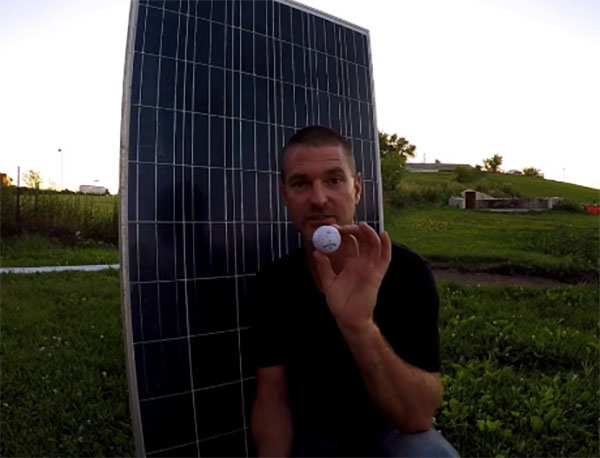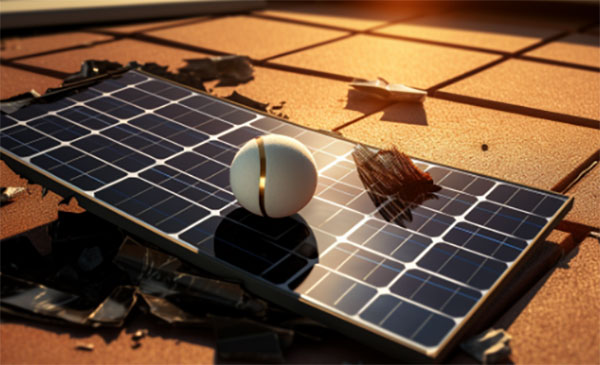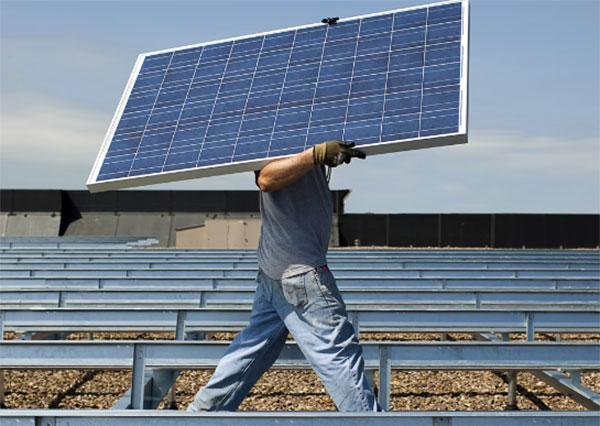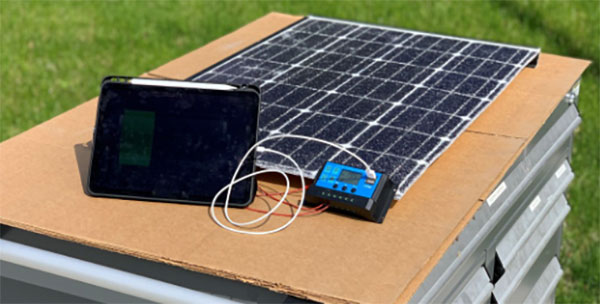Description
Install protective mesh or guards, use impact-resistant solar panels, and consider strategic placement to minimize risk.

Preventive Measures for Solar Panel Protection
Protecting solar panels from potential damage caused by golf balls is crucial for maintaining their efficiency and longevity. Various methods can be employed to safeguard these valuable assets, ensuring they continue to generate electricity effectively for years to come.
Solar Panel Guards and Mesh
Solar panel guards and mesh provide a physical barrier against golf balls and other debris. These protective layers are designed to absorb the impact, significantly reducing the risk of damage.
- Materials: Typically made from high-strength, durable materials such as aluminum or stainless steel.
- Specifications: Mesh sizes are carefully selected to prevent golf balls from passing through, usually ranging from 1/4 inch to 1 inch.
- Cost: The cost varies depending on the material and size of the solar panel array, with a general range of $10 to $30 per square foot.
- Installation: Easy to install, often requiring no specialized tools or professional assistance.
- Advantages: Not only protect against golf balls but also reduce the accumulation of leaves and other debris.
Installation of Protective Netting
Protective netting acts as a shield, catching golf balls before they can strike the solar panels. This method is particularly effective for installations near golf courses.
- Materials: Made from UV-resistant polyethylene or nylon for durability and longevity.
- Dimensions: Customizable to cover the specific area around the solar panels, with heights varying to ensure complete protection.
- Cost: The investment depends on the area covered, with prices ranging from $5 to $20 per square foot.
- Lifespan: Quality netting can last up to 10 years, depending on environmental conditions.
- Benefits: It provides a cost-effective solution with minimal impact on the solar panels' performance.
Using Impact-Resistant Solar Panels
Impact-resistant solar panels are engineered to withstand the force of golf balls and other hazards, ensuring uninterrupted power generation.
- Technology: These panels incorporate reinforced glass and frame designs to absorb impacts effectively.
- Efficiency: Despite their durability, they maintain high energy conversion rates comparable to standard panels.
- Price Range: Generally, they cost 10-20% more than conventional solar panels, reflecting their enhanced durability.
- Warranty: Manufacturers often offer extended warranties, up to 25 years, signaling confidence in their product's resilience.
- Advantages: They eliminate the need for additional protective measures, streamlining the installation process.

Solar Panel Protective Coatings
Enhancing the durability and efficiency of solar panels is crucial for maximizing their lifespan and output. One effective method to achieve this is through the application of protective coatings. These coatings not only safeguard the panels from physical impacts, such as golf balls, but also from environmental factors like dust, water, and UV radiation.
Types of Protective Coatings
Protective coatings for solar panels come in various types, each designed to offer specific benefits:
- Anti-reflective Coatings: Increase the amount of light absorbed by the solar panel, potentially enhancing its efficiency by up to 3%.
- Hydrophobic Coatings: Repel water, reducing the accumulation of dust and dirt, and simplifying the cleaning process.
- UV Protective Coatings: Protect the panels from harmful UV radiation, which can degrade the materials over time.
Materials Used:
- Silicon-based compounds are prevalent for anti-reflective coatings due to their effectiveness in increasing light absorption.
- Fluorinated compounds are typically used for hydrophobic coatings, offering excellent water-repelling properties.
Cost and Specifications:
- Price Range: The cost can vary from $1 to $5 per square foot, depending on the type and quality of the coating.
- Lifespan: Protective coatings can extend the panel's operational life by several years, with some coatings lasting up to 10 years before reapplication is necessary.
Application and Maintenance of Coatings
Application Process:
- Preparation: The surface of the solar panels must be thoroughly cleaned to ensure optimal adhesion of the coating.
- Application: Coatings are usually applied via spraying or rolling, requiring precision and uniformity.
Maintenance Tips:
- Regular Inspection: Check for signs of wear or degradation, particularly after severe weather conditions.
- Reapplication: Depending on the coating type, reapplication may be necessary every few years to maintain optimal performance.
Advantages of Protective Coatings:
- Increased Efficiency: By reducing surface reflection and dirt accumulation, coatings can significantly improve solar panel efficiency.
- Extended Lifespan: Protective coatings shield the panels from environmental damages, prolonging their operational life.

Insurance and Warranty Considerations
Ensuring your solar panels are adequately protected from unforeseen damages, such as golf ball impacts, is crucial for maintaining their efficiency and operational lifespan. Exploring insurance and warranty options can provide peace of mind and financial security.
Coverage for Damage from Golf Balls
Insurance Policies:
- Comprehensive Coverage: Look for policies that explicitly cover accidental damage, including impacts from golf balls.
- Deductibles and Premiums: Understand the policy's deductibles and premiums. A lower deductible can be beneficial for frequent claims but may result in higher premiums.
- Exclusions: Be wary of policy exclusions. Some policies may not cover damage deemed 'preventable' or outside 'normal wear and tear'.
Warranty Considerations:
- Manufacturer's Warranty: Most solar panels come with a manufacturer's warranty covering defects and sometimes efficiency guarantees. However, damage from external forces like golf balls might not be included.
- Extended Warranties: Consider purchasing an extended warranty that covers physical damage. These can add to the cost but offer additional protection.
Key Points to Remember:
- Review Coverage Details: Carefully review the insurance policy or warranty to ensure it covers damage from golf balls.
- Compare Costs: Weigh the cost of the insurance or warranty against the potential cost of repairing or replacing damaged panels.
- Check Reviews and Ratings: Research insurers and warranty providers to ensure they have a good track record of claim resolution.
How to Choose the Right Insurance Policy
Choosing the right insurance policy for your solar panels involves several critical considerations:
- Coverage Scope: Ensure the policy covers a range of damages, including environmental impacts, theft, and accidental damage.
- Claim Process: Understand the claim process's simplicity and speed. A straightforward and quick process can significantly reduce the stress of repair or replacement.
- Insurance Provider Reputation: Choose a provider with a strong reputation for customer service and claim handling.
- Cost-Benefit Analysis: Perform a cost-benefit analysis to determine if the insurance premium aligns with the potential risk of damage and repair costs.
Advantages of Adequate Insurance:
- Financial Protection: Proper insurance can shield you from significant out-of-pocket expenses for repairs or replacements.
- Peace of Mind: Knowing your investment is protected against unforeseen damages can provide considerable peace of mind.

Repair and Replacement of Damaged Solar Panels
When solar panels sustain damage, whether from golf balls, severe weather, or other external factors, assessing the extent of the damage and deciding between repair and replacement are critical steps. This guide outlines a practical approach to managing damaged solar panels, focusing on efficiency, cost, and long-term viability.
Step-by-Step Guide for Assessing Damage
- Visual Inspection: Begin with a thorough visual inspection to identify any visible signs of damage such as cracks, breaks, or dents on the solar panels.
- Performance Checks: Use a monitoring system to check for any significant drops in power output. A decrease in efficiency might indicate damage not visible to the naked eye.
- Consultation with Professionals: For a comprehensive assessment, consult with a solar panel technician. They can conduct detailed inspections, including electroluminescence (EL) tests, to detect micro-cracks and other hidden issues.
- Documentation: Document all findings with photographs and detailed notes. This documentation is crucial for insurance claims or warranty purposes.
Key Factors to Consider:
- Extent of Damage: Minor damage may not significantly affect performance, while major damage might necessitate replacement.
- Cost of Repairs vs. Replacement: Evaluate the cost-effectiveness of repairing versus replacing the damaged panels. Repairs might be more economical for minor damage, but replacement could be necessary for extensive damage.
- Warranty Status: Check if the damage is covered under the manufacturer's warranty or your insurance policy.
Options for Repair vs. Replacement
Repair Options:
- Minor Surface Damage: Can often be repaired with sealants or patches, costing between $100 to $300.
- Internal Circuit Issues: More complex repairs involving soldering or replacing damaged internal components may range from $300 to $500.
Replacement Options:
- Single Panel Replacement: If a few panels are damaged, replacing just those panels might be the best option. The cost per panel can vary widely, from $250 to $600, depending on the specifications and efficiency rating.
- Complete System Replacement: In cases of extensive damage or outdated systems, replacing the entire system might be more cost-effective in the long run. This could range from $15,000 to $25,000 for an average-sized residential system.
Considerations:
- Efficiency Loss: Even minor damage can lead to efficiency loss over time. Assess whether repair or replacement offers the best long-term efficiency.
- Matching Panels: For replacements, finding panels that match the existing system's specifications and performance characteristics is crucial.
- Warranty Implications: Understand how repairs or replacements affect the existing warranty or insurance coverage.
Advantages of Timely Action:
- Prevents Further Damage: Addressing damage promptly can prevent more significant issues, maintaining the system's efficiency and lifespan.
- Optimizes Performance: Ensuring all panels are in good condition maximizes the overall system performance and energy production.

Cost Analysis of Protection Methods
Investing in protection methods for solar panels is essential to safeguarding the system against potential damage and ensuring its longevity and efficiency. This analysis explores the initial investment required for various protection strategies versus the long-term savings they offer. Additionally, it compares the effectiveness and cost-efficiency of these strategies, including solar panel guards and mesh, protective netting, and impact-resistant solar panels.
Initial Investment vs. Long-Term Savings
Solar Panel Guards and Mesh:
- Initial Investment: Costs can range from $10 to $30 per square foot, depending on the quality and specific product.
- Long-Term Savings: By preventing damage, guards and mesh can save substantial repair and replacement costs, potentially adding years to the lifespan of the solar panels. The savings can significantly outweigh the initial investment over the lifetime of the solar system.
Protective Netting:
- Initial Investment: The price for protective netting can vary from $5 to $20 per square foot, influenced by the material's durability and area covered.
- Long-Term Savings: Protective netting minimizes the risk of damage from external objects, including golf balls, thereby reducing maintenance and repair costs. The netting also has a minimal impact on sunlight exposure, ensuring sustained energy production.
Impact-Resistant Solar Panels:
- Initial Investment: These panels typically cost 10-20% more than standard solar panels. For an average-sized residential solar system, this could mean an additional $1,000 to $5,000.
- Long-Term Savings: Impact-resistant panels are designed to withstand severe conditions without sustaining damage, which means fewer repairs and replacements. This durability can lead to significant savings, especially in areas prone to frequent environmental hazards.
Comparison of Different Protection Strategies
Effectiveness:
Solar Panel Guards and Mesh: Highly effective at preventing damage from small to medium-sized debris, including golf balls.
Protective Netting: Offers comprehensive protection from various external threats, though its effectiveness can be slightly lower for very small or high-velocity objects.
Impact-Resistant Solar Panels: Provide the highest level of protection against impact, including hail and golf balls, without sacrificing solar efficiency.
Cost-Efficiency:
Solar Panel Guards and Mesh are cost-effective for installations where the risk of impact damage is moderate.
Protective Netting is a versatile and economical choice, offering good protection for a wide range of applications with minimal installation costs.
Impact-Resistant Solar Panels represent a higher upfront cost but offer the best long-term savings due to their durability and reduced need for additional protective measures.
Considerations:
- The choice of protection method should be based on a thorough analysis of the specific risks associated with the location, the potential for damage, and the cost-benefit ratio over the solar system's expected lifespan.
- Additionally, combining protection methods (e.g., using both protective netting and impact-resistant panels) can offer comprehensive protection but at a higher initial cost.

Installation Best Practices
Ensuring the optimal performance and longevity of solar panels involves more than just selecting high-quality components; it also requires strategic placement and adherence to professional installation and maintenance standards. This guide details the best practices for solar panel installation, focusing on minimizing risk and maximizing efficiency, durability, and cost-effectiveness.
Strategic Placement to Minimize Risk
Assessing Environmental Factors:
- Location Analysis: Conduct a thorough analysis of the installation site to identify potential risks, such as areas prone to high winds, hail, or frequent golf ball impacts.
- Orientation and Angle: Optimize the orientation and tilt angle of solar panels to maximize sunlight exposure while minimizing the risk of damage from environmental factors.
Key Considerations:
- Avoidance of Falling Debris: Install panels away from trees and structures that could drop debris or cast shadows, reducing efficiency and increasing the risk of damage.
- Height and Accessibility: Consider the height at which panels are mounted to mitigate the risk from ground-level hazards, while ensuring they remain accessible for maintenance and cleaning.
Advantages of Thoughtful Placement:
- Reduced Risk of Damage: Strategic placement can significantly decrease the likelihood of damage from environmental and man-made risks.
- Optimized Performance: Proper orientation and angling enhance energy production efficiency, ensuring a higher return on investment.
Professional Installation and Maintenance Tips
Choosing the Right Installation Team:
- Certification and Experience: Select a team with certified professionals who have extensive experience in solar panel installation and are familiar with local environmental challenges and building codes.
Installation Best Practices:
Secure Mounting: Use high-quality mounting equipment designed to withstand local environmental conditions, ensuring panels are securely attached to prevent damage during adverse weather.
Wiring and Connectivity: Ensure all electrical connections are properly insulated and secured to prevent moisture ingress and electrical faults.
Maintenance Guidelines:
Regular Inspections: Schedule annual inspections to identify and address wear and tear or potential issues before they lead to significant damage.
Cleaning Regimen: Implement a regular cleaning schedule to keep panels free of debris and dirt that can reduce efficiency.
Cost and Efficiency Considerations:
Investment in Quality: Opting for higher-quality components and professional installation may have a higher upfront cost but can lead to greater long-term savings through reduced maintenance costs and higher efficiency.
Energy Yield vs. Cost: Evaluate the expected energy production against the installation cost to ensure the best value for your investment.
Long-Term Benefits:
Enhanced Durability: Adhering to best practices in installation and maintenance can extend the lifespan of solar panels, offering greater value over time.
Maximized Energy Production: Professional installation ensures that panels operate at peak efficiency, translating to higher energy yield and savings on electricity bills.









